Form 1122-0005 Semiannual PRogress Report for the Campus Program
Semi-annual Progress Report for Grants to Reduce Domestic Violence, Dating Violence, Sexual Assault and Stalking on Campus Program
CampusForm.Revised.06.16.16 Sent to Muskie_comments removed
Semi-annual Progress Report for Grants to Reduce Domestic Violence, Dating Violence, Sexual Assault and Stalking on Campus Program
OMB: 1122-0005
THIS
IS A
SAMPLE
GMS FORM.
DO
NOT
USE THIS FORM
TO
SUBMIT YOUR
FINAL
DATA
TO
OVW.
OMB
Clearance
#
1122-0005
Expiration
Date:
6/30/2011

OMB
Clearance
#
1121-0258
Expiration
Date:
07/31/2004
Office on Violence Against Women

![]() SEMI-ANNUAL
PROGRESS
REPORT
FOR
SEMI-ANNUAL
PROGRESS
REPORT
FOR
Grants to Reduce Domestic Violence, Dating Violence, Sexual Assault, and Stalking on Campus Program
Brief Instructions: This form must be completed for each Grants to Reduce Domestic Violence, Dating Violence, Sexual Assault, and Stalking on Campus Program (Campus Program) grant received. A grant administrator or coordinator must ensure that the form is completed fully with regard to all grant-funded activities. Grant partners, however, may complete sections relevant to their portion of the grant. Grant administrators or coordinators are responsible for compiling and submitting a single report that reflects all information collected from grant partners.
All grantees should read each section to determine which questions they must answer, based on the activities en- gaged in under this grant during the current reporting period:
Sections B, E, and F of this form must be completed by all grantees.
In section A, subsection A1 must be answered.
In section C, subsection C1 must be answered.
In section D and subsections A2 and C2-C7, grantees must answer an initial question about whether they engaged in certain activities during the current reporting period. If the response is yes, then the grantee must complete that section or subsection. If the response is no, the grantee may be asked to explain, and the rest of that section or subsection is skipped.
For example,
1) if you are a Campus Program grantee providing training and victim services with staff funded un- der this grant, you should complete A1, A2, B, C1, C3, D, E, and F (and answer “no” in C2 and C4-C7), or
2) if you are a Campus Program grantee providing training with staff funded under this grant, you should complete A1, A2, B, C1, C3, E, and F (and answer “no” in C2, C4-C7, and D).
The activities of volunteers or interns should be reported if they were coordinated or supervised by Campus Pro- gram-funded staff or if Campus Program funds substantially supported their activities.
For further information on filling out this form, refer to the separate set of instructions, which contains detailed definitions and examples illustrating how questions should be answered.
|
Section |
Page Number |
Section A: |
General Information |
1 |
A1: |
Grant Information |
1 |
A2: |
Staff Information |
3 |
Section B: |
Purpose Areas |
4 |
Section C: |
Function Areas |
5 |
C1: |
Minimum Requirements |
5 |
C2: |
Policies |
12 |
C3: |
Training |
15 |
C4: |
Campus Education |
19 |
C5: |
Products |
22 |
C6: |
Data Collection and Communication Systems |
23 |
C7: |
System and Capital Improvement |
24 |
Section D: |
Victim Services |
25 |
Section E: |
Campus and Community Measures |
32 |
Section F: |
Narrative |
34 |
Campus Program Semi-annual Progress Report • Office on Violence Against Women
OMB
Clearance
#
1121-0258
Expiration
Date:
07/31/2004
SECTION
A1



All grantees must complete this subsection.
![]()




![]() 2. Current
reporting
period January
1-June
30 July
1-December
31 (Year)
2. Current
reporting
period January
1-June
30 July
1-December
31 (Year)
![]() 3. Grantee
name
3. Grantee
name
![]() 4. Grant
number
4. Grant
number
(the federal grant number assigned to your Campus Program grant)
![]() 5a.
Type
of
lead
institution
5a.
Type
of
lead
institution
(Check the one answer that best describes the institution receiving the Campus Program funds.)
 Public
school
Public
school
 Private
school
Private
school
![]() 5b. Additional
designations
of
lead
institution
5b. Additional
designations
of
lead
institution
(Check all that apply.)
 Tribal
college
or
university
Tribal
college
or
university


 Historically
Black
college
or
university
Faith-based
college
or
university
Community
college
Historically
Black
college
or
university
Faith-based
college
or
university
Community
college
 College
or
university
serving
primarily
Latino
or
Hispanic
populations
College
or
university
serving
primarily
Latino
or
Hispanic
populations
 University
or
colleges
based
in
the
territories
of
Guam,
Virgin
Islands,
Puerto
Rico,
Northern
Mariana
Islands,
or
American
Samoa
University
or
colleges
based
in
the
territories
of
Guam,
Virgin
Islands,
Puerto
Rico,
Northern
Mariana
Islands,
or
American
Samoa
 College
or
university
serving
primarily
either
men
or
women
College
or
university
serving
primarily
either
men
or
women
 Other
(specify):
Other
(specify):
![]() 6. Is
this
an
OVW
Special
Initiative
to
address
violent
crimes
on
campuses
grant?
6. Is
this
an
OVW
Special
Initiative
to
address
violent
crimes
on
campuses
grant?

 Yes No If
yes,
identify:
Yes No If
yes,
identify:
![]() 7a.
Is
this
a
consortium
project?
7a.
Is
this
a
consortium
project?

 Yes No
Yes No
![]() 7b.
7b.
![]() 7b.
If
you
answered
yes
to
6 or 7aabove,
list
each
participating
member
and
indicate
the
number
of
each
type
of
institution
represented
in
your
project
in
7d
and
7e.
7b.
If
you
answered
yes
to
6 or 7aabove,
list
each
participating
member
and
indicate
the
number
of
each
type
of
institution
represented
in
your
project
in
7d
and
7e.
Institution name:
(1) (2) (3) (4)
![]() 7d.
Type
of
institution
7d.
Type
of
institution
(Report the number of each type of institution of your project members.)

 Public
school Private
school
Public
school Private
school
![]() 7e.
Additional
designation
of
participating
institutions
7e.
Additional
designation
of
participating
institutions
 (Report
the
number
of
each
type
of
institution
represented
in
your
project)
(Report
the
number
of
each
type
of
institution
represented
in
your
project)
-
Type of institution
Number
Tribal school
Historically Black college
Faith-based
Community college
Latino or Hispanic
Territory-based
Single sex
Other (specify):
![]() 8. Point
of
contact
8. Point
of
contact
(Program Coordinator or person responsible for the day-to-day coordination of the grant)
First name MI Last name Institution name Address City State Zip code
Telephone Facsimile
![]() 9. Does
this
grant
specifically
address
tribal
populations?
9. Does
this
grant
specifically
address
tribal
populations?
(Check yes if your Campus Program grant focuses on tribal populations, and indicate which tribes or
nations you serve or intend to serve.)

 Yes No If
yes,
which tribes/nations:
Yes No If
yes,
which tribes/nations:
![]() 10.
What
percentage
of
your
Campus
Program
funds
was
directed
to
each
of
these
areas?
10.
What
percentage
of
your
Campus
Program
funds
was
directed
to
each
of
these
areas?
(Report the area(s) addressed by your Campus Program grant during the current reporting period and estimate the approximate percentage of funds [or resources] used to address each area [consider edu- cation, training, victim services, etc.]. The grantee may choose how to make this determination. If the Campus Program grant funds a consortium project, responses in this question should reflect the aggregated responses of project members.)
Throughout this form, the term sexual assault any nonconsensual sexual act proscribed by Federal, tribal, or State law, including when the victim lacks capacity to consent.
The term domestic violence/dating vio- lence applies to any pattern of coercive behavior that is used by one person to gain power and control over a current or former intimate partner or dating partner. Stalking is defined as a course of conduct directed at
 a
specific
person
that
would
cause
a
reasonable
person
to
fear
for
his
or
her
safety
or
the
safety
of
others,
or
suffer
substantial
emotional
distress.
(See
separate
instructions
for
more
complete
definitions.)
a
specific
person
that
would
cause
a
reasonable
person
to
fear
for
his
or
her
safety
or
the
safety
of
others,
or
suffer
substantial
emotional
distress.
(See
separate
instructions
for
more
complete
definitions.)
Percentage of grant funds
OMB
Clearance
#
1121-0258
Expiration
Date:
07/31/2004
Domestic violence/dating violence
Stalking
TOTAL (must equal 100 %)
100%
OMB
Clearance
#
1121-0258
Expiration
Date:
07/31/2004
SECTION




Were Campus Program funds used to fund staff positions during the current reporting period?
Check yes if Campus Program funds were used to pay staff, including part-time staff and contractors. (If
the grant funds a consortium project, responses in this subsection should reflect the aggre-
gated responses of project members
 Yes—answer
question
11
Yes—answer
question
11
 No—skip
to
section
B
No—skip
to
section
B
![]() 11.
Staff
11.
Staff
(Report the total number of full-time equivalent [FTE] staff funded by the Campus Program grant during
the current reporting period. Report staff by functions performed, not by title or location. Include em-
ployees who are part-time and/or only partially funded with these grant funds as well as consultants/
contractors. If an employee or contractor was employed or utilized for only a portion of the reporting
period, prorate appropriately. For example, if you hired a full-time advocate in October who was 100%
funded with Campus Program funds, you would report that as .50 FTE. Report all FTEs in decimals, not
percentages. One FTE is equal to 1,040 hours—40 hours per week x 26 weeks. See separate instruc-
 tions
for
examples
of
how
to
calculate
and
prorate
FTEs.)
tions
for
examples
of
how
to
calculate
and
prorate
FTEs.)
-
Staff
FTE(s)
Administrator (director, fiscal manager)
Attorney
Campus police/security officer
Counselor
Evaluator
Information technology staff
Legal advocate (does not include attorney or paralegal)
Paralegal
Program coordinator (training coordinator, victim services coordinator)
Support staff (administrative assistant, bookkeeper, accountant)
Trainer/educator (includes peer educators if paid)
Victim advocate (includes domestic violence, sexual assault, dual)
Other (specify):
TOTAL
SECTION
B


All grantees must complete this section.
(If the grant funds a consortium project, responses in this section
should reflect the aggregated responses of project members.)
![]() 12.
Statutory
purpose
areas
12.
Statutory
purpose
areas
(Check all purpose areas that apply to activities supported with Campus Program funds during the cur-
rent reporting period.)
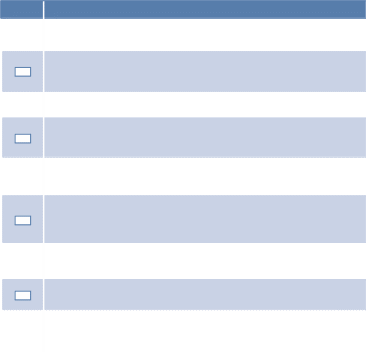 Check
ALL
Check
ALL
 that
apply
that
apply
Purpose areas
To provide personnel, training, technical assistance, data collection, and other equipment with respect to the increased apprehension, investigation, and adjudication of people committing domestic violence, dating violence, sexual assault, and stalking on campus.
To develop, strengthen and implement campus policies, protocols, and services that more effectively identify and respond to the crimes of domestic violence, dating violence, sexual assault, and stalking, to include the use of technology to commit these crimes, and to train campus administrators, campus security personnel, and personnel serving on campus disciplinary boards on such policies, protocols, and services.
 To
implement
and
operate
education
programs
for
the
prevention
of
domestic
violence,
dating
violence,
sexual
assault,
and
stalking.
To
implement
and
operate
education
programs
for
the
prevention
of
domestic
violence,
dating
violence,
sexual
assault,
and
stalking.
To develop, enlarge, or strengthen victim services programs, and population specific services on the campuses of institu tions involved, including programs providing legal, medical, or psychological counseling, for victims of domestic violence, dating violence, sexual assault, and stalking, and to im- prove delivery of victim assistance on campus.
 To
create,
disseminate,
or
otherwise
provide
assistance
and
information
about
victims’
options
on
and
off
campus
to
bring
disciplinary
or
other
legal
action,
including
assistance to
victims
in immigration matters.
To
create,
disseminate,
or
otherwise
provide
assistance
and
information
about
victims’
options
on
and
off
campus
to
bring
disciplinary
or
other
legal
action,
including
assistance to
victims
in immigration matters.
To develop, install, or expand data collection and communication systems, including com- puterized systems, linking campus security to local law enforcement for the purpose of identifying and tracking arrests, protection orders, violations of protection orders, prosecu- tions, and convictions with respect to the crimes of domestic violence, dating violence, sexual assault, and stalking on campus.
 To
provide
capital
improvements
(including
improved
lighting
and
communications
facili-
ties,
but
not
including
the
construction
of
buildings)
on
campuses
to
address
the
crimes
of
dating
violence,
domestic
violence,
sexual
assault,
and
stalking.
To
provide
capital
improvements
(including
improved
lighting
and
communications
facili-
ties,
but
not
including
the
construction
of
buildings)
on
campuses
to
address
the
crimes
of
dating
violence,
domestic
violence,
sexual
assault,
and
stalking.
To support improved coordination among campus administrators, campus security per- sonnel, and local law enforcement to reduce domestic violence, dating violence, sexual assault, and stalking on campus.
To develop or adapt and provide developmental, culturally appropriate, and linguistically accessible print or electronic materials to address both prevention and intervention in domestic violence, dating violence, sexual violence and stalking.
To develop or adapt population specific strategies and projects for victims of domestic violence, dating violence, sexual assault, and stalking from underserved populations on campus.
OMB
Clearance
#
1121-0258
Expiration
Date:
07/31/2004
![]() 13.
Program
priority
areas
addressed
by
your
grant
13.
Program
priority
areas
addressed
by
your
grant
(In addition to the purpose areas identified above, the Campus Program Grant Application and Program
Guidelines may have identified several areas that would receive priority consideration. If your program
 addressed
any
of
these
priority
areas
during the current
reporting
period,
list
them
below.)
addressed
any
of
these
priority
areas
during the current
reporting
period,
list
them
below.)
OMB
Clearance
#
1121-0258
Expiration
Date:
07/31/2004
SECTION
C1


All grantees must complete this subsection.
(If the grant funds a consortium project, responses in this subsection should reflect the aggregated responses of project members.)
For purposes of this reporting form, education means providing general information that will increase public awareness of sexual assault, dating violence, domestic violence, or stalking. Training means providing information on sexual assault, dating violence, domestic violence, and stalking that enables professionals to improve their response to victims/survivors as it relates to their role in the system.
![]() 14.
Prevention
and
education
program
events
provided
for
all incoming
students
14.
Prevention
and
education
program
events
provided
for
all incoming
students
(Report the total number of prevention and education program events supported with Campus Program
funds provided for incoming students during the current reporting period. Report the number of preven-
tion and education program events supported with a funding source other than your Campus Program
grant provided to incoming students during the current reporting period.)
 Total
number
of
prevention
and
education
program
events
provided
with
Campus
Program
funds
Total
number
of
prevention
and
education
program
events
provided
with
other
funding
sources
Total
number
of
prevention
and
education
program
events
provided
Total
number
of
prevention
and
education
program
events
provided
with
Campus
Program
funds
Total
number
of
prevention
and
education
program
events
provided
with
other
funding
sources
Total
number
of
prevention
and
education
program
events
provided
![]() 15.
Was
the
mandatory
prevention
and
education
events
held during the reporting period for
all incoming
students
developed
in
collaboration
with
campus
and
community-based
victim
advocacy
organizations?
15.
Was
the
mandatory
prevention
and
education
events
held during the reporting period for
all incoming
students
developed
in
collaboration
with
campus
and
community-based
victim
advocacy
organizations?

 Yes No
Yes No
![]() 16a.
Prevention
and
education
for
all incoming
students
16a.
Prevention
and
education
for
all incoming
students
(In the first column, report the number of incoming students during the current reporting period. In the
second column; report the number of incoming students who received prevention and education sup-
ported with Campus Program funds during the current reporting period. In the third column, report the
number of incoming students who received prevention and education supported with a funding source
other than Campus Program funds during the current reporting period.)
-
Total number incoming students
Number educated with Campus Program funds
Number educated with other funding sources
Number incoming not educated
Incoming students

![]() 16b.
If
all
incoming
students
were
not
provided
with
prevention
education
during this reporting period,
please
explain
in
the
box
below.
(For example, provide the time of year (fall, spring, summer) that
the prevention education is provided.
16b.
If
all
incoming
students
were
not
provided
with
prevention
education
during this reporting period,
please
explain
in
the
box
below.
(For example, provide the time of year (fall, spring, summer) that
the prevention education is provided.
![]() 17.
Topics
of
prevention
and
education
program
events
for
all incoming
students
17.
Topics
of
prevention
and
education
program
events
for
all incoming
students
(Indicate all topics addressed in the prevention and education program events provided to incoming
 students
during
the current
reporting
period.
Check
all
that
apply.)
students
during
the current
reporting
period.
Check
all
that
apply.)




 Dating
violence
prevention
Domestic
violence
prevention
Sexual
assault
prevention
Stalking prevention
Dating
violence
prevention
Domestic
violence
prevention
Sexual
assault
prevention
Stalking prevention
 Dating
violence
overview,
dynamics,
and
services
Dating
violence
overview,
dynamics,
and
services
Domestic violence overview, dynamics, and services
 Sexual
assault
overview,
dynamics,
and
services
Sexual
assault
overview,
dynamics,
and
services
 Stalking
overview,
dynamics,
and
services
Stalking
overview,
dynamics,
and
services
Bystander Intervention
 Other
(specify):
Other
(specify):
![]() 18.
Traini
events
provided
for
all campus
police/security
officers
and
campus
disciplinary
board
members
18.
Traini
events
provided
for
all campus
police/security
officers
and
campus
disciplinary
board
members
(Report the total number of training events supported with Campus Program funds provided for campus police/security officers and campus disciplinary board members during the current report-ing period. Report the number of training program events supported with a funding source other than your Campus Program grant provided for campus police/security officers and campus disciplinary board members during the current reporting period. Report total number of events for each group and each funding source in the total sections.)
-
Number of training events heldwith
Campus Program funds
Number of training events held with another funding source
Total events held





 Campus
police/security
officers
Campus
police/security
officers
-
Campus disciplinary board members
Total events
![]() 19.
Were
the
training
programs
for
all campus
police/security
officers
and
campus
disciplinary
board
members
developed
in
collaboration
with
campus
and
community-based
victim
advocacy
organizations?
19.
Were
the
training
programs
for
all campus
police/security
officers
and
campus
disciplinary
board
members
developed
in
collaboration
with
campus
and
community-based
victim
advocacy
organizations?

 Yes No
Yes No
![]() 20.
Training
for
all campus
police/security
officers
andcampus
disciplinary
board
members
20.
Training
for
all campus
police/security
officers
andcampus
disciplinary
board
members
(In the first column, report the number of campus police/security officers and campus disciplinary
board members who received training supported with Campus Program funds during the current
reporting period. In the second column, report the number of campus police/security officers and ju-
dicial/disciplinary board members who received training supported with a funding source other than
Campus Program funds during the current reporting period. In the third column, report the numbers of
those who did not receive training during the current reporting period, and in the last column, report
 the
total.
Report
the
total
of
each
column in the last
row.)
the
total.
Report
the
total
of
each
column in the last
row.)
OMB
Clearance
#
1121-0258
Expiration
Date:
07/31/2004
Campus police/security officers
Campus disciplinary board members
Total
Number trained with Campus Program funds
Number trained with another funding source
Number not
trained Total
21. Training content areas for campus police/security officers and judicial/disciplinary board members
(Indicate all topics covered in training program events provided to campus police/security officers and judicial/disciplinary board members during the current reporting period. Check all that apply.)
OMB
Clearance
#
1121-0258
Expiration
Date:
07/31/2004
Sexual assault, dating violence, domestic violence, and stalking
 Confidentiality
Confidentiality
 Dating
violence
overview,
dynamics,
and
services
Dating
violence
overview,
dynamics,
and
services
 Domestic
violence
overview,
dynamics,
and
services
Domestic
violence
overview,
dynamics,
and
services
 Drug-facilitated
sexual
assault
Drug-facilitated
sexual
assault
 Safety
planning
for
victims/survivors
Safety
planning
for
victims/survivors
 Sexual
assault
overview,
dynamics,
and
services
Sexual
assault
overview,
dynamics,
and
services
 Stalking/cyberstalking
overview,
dynamics,
and
services
Stalking/cyberstalking
overview,
dynamics,
and
services
□ Trauma Informed Response
□ Victim Accommodations
Bystander Intervention
 Other
(specify):
Other
(specify):

 Justice
and
disciplinary
systems
Campus
police/security
response
Civil court
procedures
Justice
and
disciplinary
systems
Campus
police/security
response
Civil court
procedures
 Criminal
court
procedures
Criminal
court
procedures
 Disciplinary
response
Disciplinary
response
 Domestic
violence/dating
violence
statutes/
Domestic
violence/dating
violence
statutes/
codes
 Firearms
and
domestic
violence/dating
violence
Firearms
and
domestic
violence/dating
violence
 Identifying
predominant
aggressor/
Identifying
predominant
aggressor/
decreasing dual arrests

 Mandatory
reporting
requirements
Mandatory
reporting
requirements
 Protection
orders
(including
full faith and
credit)
Protection
orders
(including
full faith and
credit)
 Sexual
assault
statutes/codes
Sexual
assault
statutes/codes
 Stalking
statutes/codes
Stalking
statutes/codes
Victims Accommodations
Investigations
Student Code of Conduct
Sanctions and/or Dispositions
Other (specify):
Underserved populations
Issues specific to victims/survivors who:
 live
in
rural
areas
live
in
rural
areas

 are
American
Indian
or
Alaska
Native
are
Asian
are
American
Indian
or
Alaska
Native
are
Asian

 are
Black
or
African
American
have
disabilities
are
Black
or
African
American
have
disabilities
Deaf and/or hard of hearing
 are
elderly
are
elderly
 are
Hispanic
or
Latino
are
Hispanic
or
Latino
 are
homeless
or
living
in poverty
are
homeless
or
living
in poverty
 are
immigrants,
refugees,
or
asylum
seekers
are
immigrants,
refugees,
or
asylum
seekers
 are
lesbian,
gay,
bisexual,
transgender,
or
intersex
are
lesbian,
gay,
bisexual,
transgender,
or
intersex
 are
Native
Hawaiian
or
other
Pacific
are
Native
Hawaiian
or
other
Pacific
Islander

 have
mental
health
issues
have
substance
abuse
issues
have
limited
English
proficiency
have
mental
health
issues
have
substance
abuse
issues
have
limited
English
proficiency
International students
Students abroad
 Other
(specify):
Other
(specify):

 Campus
and
community
response
Campus
response
to
sexual
assalt
Clery
Act
reporting
Campus
and
community
response
Campus
response
to
sexual
assalt
Clery
Act
reporting


 Coordinated
community
response
Response
teams
(DART,
DVRT,
SART)
Use
and misuse of technology
Coordinated
community
response
Response
teams
(DART,
DVRT,
SART)
Use
and misuse of technology
 Other
(specify):
Other
(specify):
Title IX
Retaliation
OMB Clearance # 1122-0005
Expiration Date: 6/30/2011
![]() 22.
Coordinated
campus-based
community
response
activities
supported
by
Campus
Program
funds
during
the
current
reporting
period
22.
Coordinated
campus-based
community
response
activities
supported
by
Campus
Program
funds
during
the
current
reporting
period
(Check the appropriate boxes to indicate the campus-based groups or offices, even if they are not partners with which you have an internal memorandum of understanding [IMOU], that you provided victim/survivor referrals to, received referrals from, engaged in consultation with, provided technical assistance to, and/or attended meetings with, according to the usual frequency of those interactions. If the interactions were not part of a regular schedule, you will need to estimate the frequency with which these interactions occurred during the current reporting period. In the last column, indicate the
campus-based groups or offices with which you have an IMOU for the purposes of the Campus Program
 grant.)
grant.)
OMB
Clearance
#
1121-0258
Expiration
Date:
07/31/2004

















 Academic
deans/
Academic
deans/
Directors
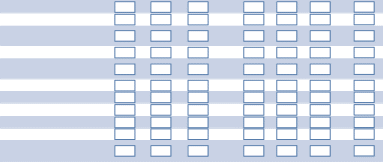 Academic
departments
Athletics
department
Campus
police/security
Academic
departments
Athletics
department
Campus
police/security
department
Counseling center
Disciplinary/judicial office or board
Faculty senate
Faith-based services
Greek affairs
Health center
Human resources

 Office
of the President/Chancellor
Office
of the President/Chancellor
Residential life

 Student
affairs
(multicultural
center,
career services)
Student
affairs
(multicultural
center,
career services)
 Student
groups
(students of color; LGTBQ, etc.)
Student
groups
(students of color; LGTBQ, etc.)
Student senate
Title IX Office
Victim/survivor groups
Women’s center



Other (specify):
Victim/survivor referrals,

 consultations,
technical
assistance Meetings
consultations,
technical
assistance Meetings






 Daily Weekly Monthly Weekly Monthly
Quarterly
Daily Weekly Monthly Weekly Monthly
Quarterly
IMOU Partner
OC 23. (Optional) Additional information
OMB Clearance# 1122-0005
Expiration Date: 6/30/2011
(Use the space below to discuss the effectiveness of coordinated community response [CCR] activi-
 ties
funded
or
supported
by
your
Campus
Program
grant
and
to
provide
any
additional
information
you
would
like
to
share
about
your
campus-based
CCR
activities
beyond
what
you
have
provided
in
the
data
above.
Examples
might
include
improved
information
to
victims/survivors
regarding
available
resources
and
greater
coordination
between
departments
on
campus.)
(Maximum
-
2000
characters)
ties
funded
or
supported
by
your
Campus
Program
grant
and
to
provide
any
additional
information
you
would
like
to
share
about
your
campus-based
CCR
activities
beyond
what
you
have
provided
in
the
data
above.
Examples
might
include
improved
information
to
victims/survivors
regarding
available
resources
and
greater
coordination
between
departments
on
campus.)
(Maximum
-
2000
characters)
![]() 24.
Coordinated
community-based
response
activities
supported
by
Campus
Program
funds
during
the
current
reporting
period
24.
Coordinated
community-based
response
activities
supported
by
Campus
Program
funds
during
the
current
reporting
period
 (Check
the
appropriate
boxes
to
indicate
the community-based
agencies,
organizations, or
groups,
even
if they
are
not
partners
with
which
you
have
an external
memorandum
of
understanding
[EMOU],
that you
provided
victim/survivor
referrals
to,
received
referrals
from,
engaged
in consultation with, provided
technical
assistance
to,
and/or
attended
meetings
with,
according
to
the
usual frequency
of
the
inter-
actions. If
the
interactions
were
not
part
of
a
regular schedule,
you
will
need
to
estimate
the
frequency
with which
these interactions
occurred
during
the current
reporting
period.
If
Campus
Program-funded
staff
participated
in
a task
force
or
work
group,
indicate
that
under
“Meetings”
by
checking
the frequency
of
the
meetings
and
the
types
of
organizations
participating.
In
the
last
column,
indicate
the community-based
agencies,
organizations, or
groups
with which
you
have
an EMOU
for
purposes
of
the
Campus
Program
grant.)
(Check
the
appropriate
boxes
to
indicate
the community-based
agencies,
organizations, or
groups,
even
if they
are
not
partners
with
which
you
have
an external
memorandum
of
understanding
[EMOU],
that you
provided
victim/survivor
referrals
to,
received
referrals
from,
engaged
in consultation with, provided
technical
assistance
to,
and/or
attended
meetings
with,
according
to
the
usual frequency
of
the
inter-
actions. If
the
interactions
were
not
part
of
a
regular schedule,
you
will
need
to
estimate
the
frequency
with which
these interactions
occurred
during
the current
reporting
period.
If
Campus
Program-funded
staff
participated
in
a task
force
or
work
group,
indicate
that
under
“Meetings”
by
checking
the frequency
of
the
meetings
and
the
types
of
organizations
participating.
In
the
last
column,
indicate
the community-based
agencies,
organizations, or
groups
with which
you
have
an EMOU
for
purposes
of
the
Campus
Program
grant.)
Community-based agency/
organization/group

 Victim/survivor
referrals,
consultations,
technical
assistance
Victim/survivor
referrals,
consultations,
technical
assistance
Meetings
EMOU
partner
 Advocacy
organization
(NAACP,
LGBTQ
organization)
Advocacy
organization
(NAACP,
LGBTQ
organization)
Daily Weekly Monthly Weekly Monthly Quarterly
-
Community Based Organization











 Court
Court
Domestic violence organization






 Dual
sexual
assault
and
domestic
violence
organiza
Dual
sexual
assault
and
domestic
violence
organiza













 Faith-based
organization
Faith-based
organization
-
Government agency
(vocational rehabilitation, food stamps, TANF)
Health/mental health organization
Law enforcement (excluding campus police/security)





















 Legal
organization
(legal
services,
bar
association,
law
school)
Legal
organization
(legal
services,
bar
association,
law
school)
Prosecutor’s office
Sexual assault organization







 Social
service
organization
Social
service
organization
Tribal government/Tribal government agency






 Other
(specify):
Other
(specify):
25. (Optional) Additional information
 (Use
the
space
below
to
discuss
the
effectiveness
of
community-based
CCR
activities
funded
or
supported
by
your
Campus
Program
grant
and
to
provide
any
additional
information
you
would
like
to
share
about
your
community-based
CCR
activities
beyond
what
you
have
provided
in
the
data
above.
Examples
might
include
an
improved
response
to
victims/survivors
of
domestic
violence/dating
violence
following
meetings
of
a
regional
task
force;
improved
information
to
victims/survivors
regarding
resources
and
greater
coordination
between
the
campus
and
the
local
victim
services
agency
as
the
result
of
meetings
between
campus
and
community
advocates.)
(Maximum-
2000
characters)
(Use
the
space
below
to
discuss
the
effectiveness
of
community-based
CCR
activities
funded
or
supported
by
your
Campus
Program
grant
and
to
provide
any
additional
information
you
would
like
to
share
about
your
community-based
CCR
activities
beyond
what
you
have
provided
in
the
data
above.
Examples
might
include
an
improved
response
to
victims/survivors
of
domestic
violence/dating
violence
following
meetings
of
a
regional
task
force;
improved
information
to
victims/survivors
regarding
resources
and
greater
coordination
between
the
campus
and
the
local
victim
services
agency
as
the
result
of
meetings
between
campus
and
community
advocates.)
(Maximum-
2000
characters)
SECTION

OMB Clearance # 1122-0005
Expiration Date: 6/30/2011
Were your Campus Program funds used to develop, substantially revise, or implement policies or protocols during the current reporting period?
Check yes if Campus Program-funded staff developed, substantially revised, or implemented policies or protocols, or if Campus Program funds directly supported the development, revision, or implementation of policies or protocols.
 Yes--answer
questions
26-27
Yes--answer
questions
26-27
 No--skip
to
C3
No--skip
to
C3
![]() 26.
Types
of
policies
or
protocols
developed,
substantially
revised,
or
implemented
during
the
current
reporting
period
26.
Types
of
policies
or
protocols
developed,
substantially
revised,
or
implemented
during
the
current
reporting
period
(Check all that apply.)
Law enforcement
Campus Community

 based
based
based
Appropriate response to underserved populations Identifying primary aggressor/discouraging dual arrest Immediate access to protection order information

 Mandatory
training
on
sexual
assault,
domestic
violence/dating
violence,
and
stalking
Procedures
for
anonymous,
confidential,
or
Jane
Doe
reporting
of
sexual
assault
Sexual
assault
response
and
protocols
Mandatory
training
on
sexual
assault,
domestic
violence/dating
violence,
and
stalking
Procedures
for
anonymous,
confidential,
or
Jane
Doe
reporting
of
sexual
assault
Sexual
assault
response
and
protocols
Policies to protect victims/survivors from internet disclosure of identifying information

 No
charge
to
victims/survivors
for
any
costs
related
to
the
investigation
of
sexual
assault,
No
charge
to
victims/survivors
for
any
costs
related
to
the
investigation
of
sexual
assault,
domestic violence/dating violence, and/or stalking incidents
 No
charge
to
sexual
assault
victim/survivor
for
any
costs
associated
with
forensic
exam
No
charge
to
sexual
assault
victim/survivor
for
any
costs
associated
with
forensic
exam
No victims/survivors polygraphed
Pro-arrest/mandatory arrest
Protection order enforcement (including full faith and credit)
Providing information to victims/survivors about victim services
Other (specify):
 Victim
services
Victim
services
Campus Community
OMB
Clearance
#
1121-0258
Expiration
Date:
07/31/2004




based
Appropriate services for underserved populations
Appropriate response to victims/survivors with substance abuse issues and/or mental health diagnoses
 Confidentiality
Confidentiality
Disciplinary policy and procedures
Mandatory training standards for staff and volunteers
Protocols with campus police/security

 Staff,
board,
and/or
volunteers
represent
the
diversity
of
your
service
area
Procedures
for
anonymous,
confidential,
or
Jane
Doe
reporting
of
sexual
assault
Victim/survivor
informed
about
Crime
Victims
Compensation
and
victim impact
statements
Other
(specify):
Staff,
board,
and/or
volunteers
represent
the
diversity
of
your
service
area
Procedures
for
anonymous,
confidential,
or
Jane
Doe
reporting
of
sexual
assault
Victim/survivor
informed
about
Crime
Victims
Compensation
and
victim impact
statements
Other
(specify):
Health care
Campus Community
Student conduct code
 Dating
violence
policy
Dating
violence
policy







 based
based
based
Advocate response to emergency room/campus health center
Appropriate response to under- served populations
Forensic evidence collection and documentation
Mandatory training on sexual as- sault, domestic violence/dating violence, and stalking
Routine screening and referrals for sexual assault, domestic violence/ dating violence, and stalking
Other (specify):
Domestic violence policy Sexual assault policy Stalking policy
Other (specify):
 Campus
response
Clery
Act
reporting
Data
collection
Campus
response
Clery
Act
reporting
Data
collection
Coordinated campus/community response Response teams (DART, DVRT, SART) Sexual assault response and protocols
Other (specify):



 Campus
disciplinary
board
(campus-based)
Campus
disciplinary
board
(campus-based)
 Accelerated
hearing
schedules
Accelerated
hearing
schedules
Appropriate response to underserved populations
 Confidentiality
Confidentiality
 Mandatory
training
on
sexual
assault,
domestic
violence/dating
violence,
and
stalking
Mandatory
training
on
sexual
assault,
domestic
violence/dating
violence,
and
stalking
 Discouraging
mediation
Discouraging
mediation
 Procedures
for
disciplinary
hearing
security
Procedures
for
disciplinary
hearing
security
 Sanctions
Sanctions
Victim/survivor notification
 Other
(specify):
Other
(specify):
Justice system (community-based)
 Civil
court
procedures
Civil
court
procedures
Criminal court procedures
 Decreasing
dual
arrests/identifying
predominant
aggressor
Decreasing
dual
arrests/identifying
predominant
aggressor
 Domestic
violence/dating
violence
statutes/
Domestic
violence/dating
violence
statutes/
codes
 Firearms
and
domestic
violence/dating
violence
Firearms
and
domestic
violence/dating
violence
Judicial response
Law enforcement response Pro-arrest policies Prosecution response
Protection orders (including full faith and credit)
Sexual assault response and protocols
Sexual assault statutes/codes
Stalking statutes/codes
 Other
(specify):
Other
(specify):
27. (Optional) Additional information
 (Use
the
space
below
to
discuss
the
effectiveness
of
policies
funded
or
supported
by
your
Campus
Program
grant
that
you
have
developed
or
implemented
and
to
provide
any
additional
information
you
would
like
to
share
about
your
activities
relating
to
the
developing,
revising
or
implementing
of
policies
beyond
what
you
have
provided
in
the
data
above.)
(Maximum-
2000
characters)
(Use
the
space
below
to
discuss
the
effectiveness
of
policies
funded
or
supported
by
your
Campus
Program
grant
that
you
have
developed
or
implemented
and
to
provide
any
additional
information
you
would
like
to
share
about
your
activities
relating
to
the
developing,
revising
or
implementing
of
policies
beyond
what
you
have
provided
in
the
data
above.)
(Maximum-
2000
characters)
OMB
Clearance
#
1121-0258
Expiration
Date:
07/31/2004
SECTION


Were your Campus Program funds used for training during the current reporting period?
Check yes if Campus Program-funded staff provided training or if grant funds directly supported the
training. (If the grant funds a consortium project, responses in this subsection should reflect
the aggregated responses of project members.)
 Yes—answer
questions
28-31
Yes—answer
questions
28-31
No—skip to C4
For the purposes of this reporting form, training is providing information on sexual assault, domestic violence, dating violence, and stalking that enables professionals to improve their response to victims/ survivors as it relates to their role in the system. Education is providing general information that will increase public awareness of sexual assault, domestic violence, dating violence, or stalking. In this sub- section, report information on training activities. Report education activities in subsection C4.
![]() 28.
Training
events
provided
28.
Training
events
provided
(Report the total number of training events provided with Campus Program funds during the current
reporting period. Exclude those events reported in subsection C1, Minimum Requirements, where you
report on events provided for incoming students and campus police/security and judicial disciplinary
board members. Training provided to Campus Program-funded staff should not be counted.)
 Total
number
of
training
events
provided
Total
number
of
training
events
provided
OMB
Clearance
#
1121-0258
Expiration
Date:
07/31/2004
![]()
(Report the number of people trained with Campus Program funds during the current reporting period.
Use the category that is most descriptive of the people attending the training event. Exclude those re-
ported in subsection C1. Campus Program-funded staff attending training events should not be count-
ed as people trained. If you do not know how many people to report in specific categories, you may
report the overall number in “Multidisciplinary,” but this category should be used only as a last resort.
Students, community members, and victims/survivors should not be reported as people trained, since
they are not professionals responding to victims/survivors.)
-
People trained
Number
Advocacy organization staff (NAACP, LGBTQ organization)
Administrators and Campus Leadership
Attorneys/law students
Faculty and Staff )(i.e. Clery Reporters/ Title IX Coordinators and Residential Life, Athletic Department))
Faith-based organization staff
Health professionals (doctors, nurses, health center staff)
Local Law enforcement officers
Mental health professionals
Peer educators
Pre-professional students (students who will serve victims/survivors in a professional capacity upon completion of their program, e.g., social work, medical, psychology students)



-
Victim advocates (includes domestic violence sexual assault ordual)
Volunteers
Other (specify):
TOTAL
30. Training content areas
(Indicate all topics covered in training events provided by your Campus Program funds during the cur-
rent reporting period. Do not include training events attended by Campus Program-funded staff. Check
all that apply.)
OMB
Clearance
#
1121-0258
Expiration
Date:
07/31/2004
 Confidentiality
Confidentiality
 Dating
violence
overview,
dynamics,
and
services
Dating
violence
overview,
dynamics,
and
services
 Domestic
violence
overview,
dynamics,
and
services
Domestic
violence
overview,
dynamics,
and
services
 Drug-facilitated
sexual
assault
Drug-facilitated
sexual
assault
 Safety
planning
for
victims/survivors
Safety
planning
for
victims/survivors
 Sexual
assault
overview,
dynamics,
and
services
Sexual
assault
overview,
dynamics,
and
services
 Stalking
overview,
dynamics,
and
services
Stalking
overview,
dynamics,
and
services
 Response
to
victims/survivors
who
are
in-
carcerated
Response
to
victims/survivors
who
are
in-
carcerated
Bystander Intervention
 Other
(specify):
Other
(specify):

 Justice
and
disciplinary
systems
Campus
police/security
response
Civil court
procedures
Justice
and
disciplinary
systems
Campus
police/security
response
Civil court
procedures
 Criminal
court
procedures
Criminal
court
procedures
 Disciplinary
response
Disciplinary
response
 Domestic
violence/dating
violence
stat-
utes/codes
Domestic
violence/dating
violence
stat-
utes/codes
 Firearms
and
domestic
violence/dating
violence
Firearms
and
domestic
violence/dating
violence
 Identifying
predominant
aggressor/
Identifying
predominant
aggressor/
decreasing dual arrests
 Mandatory
reporting
requirements
Mandatory
reporting
requirements
 Protection
orders
(including
full faith and
credit)
Protection
orders
(including
full faith and
credit)
 Sexual
assault
statutes/codes
Sexual
assault
statutes/codes
 Stalking
statutes/codes
Stalking
statutes/codes
Victims’ Accommodations
Investigations
Student Code of Conduct
Sanctions and/or Dispositions
Other (specify):
Underserved populations
Issues specific to victims/survivors who:

 are
American
Indian
or
Alaska
Native
are
Asian
are
American
Indian
or
Alaska
Native
are
Asian


 are
Black
or
African
American
are
elderly
are
Black
or
African
American
are
elderly
are Hispanic or Latino
 are
homeless
or
living
in poverty
are
homeless
or
living
in poverty
 are
immigrants,
refugees,
or
asylum
seekers
are
immigrants,
refugees,
or
asylum
seekers
 are
international
students
are
international
students
 are
lesbian,
gay,
bisexual,
transgender,
or
intersex
are
lesbian,
gay,
bisexual,
transgender,
or
intersex
 are
Native
Hawaiian
or
other
Pacific
are
Native
Hawaiian
or
other
Pacific
Islander
 are
non-traditional
or
older
students
have
disabilities
are
non-traditional
or
older
students
have
disabilities
Deaf and/or Hard of Hearing

 have
limited
English
proficiency
have
limited
English
proficiency
have mental health issues
 have
substance
abuse
issues
live
in
rural
areas
have
substance
abuse
issues
live
in
rural
areas
International Students
Students Abroad
 Other
(specify):
Other
(specify):
Campus and community response
 Clery
Act
reporting
Clery
Act
reporting


 Campus
response
to
sexual
assault
Campus
response
to
sexual
assault
Coordinated community response Response teams (DART, DVRT, SART) Use and misuse of technology
Other (specify):
OC 31. (Optional) Additional information
OMB Clearance# 1122-0005
Expiration Date: 6/30/2011
(Use the space below to discuss the effectiveness of training activities funded or supported by your
 Campus
Program
grant
and
to
provide
any
additional
information
you
would
like
to
share
about
your
training
activities
beyond
what
you
have
provided
in
the
data
above.
Examples
might
include
improved
system
response
to
victims/survivors
with
disabilities
following
a
multidisciplinary
training
on
issues
specific
to
victims/survivors
with
disabilities,
or
greater
awareness
and
reporting
of
drug-facilitated
sexual
assault.)
(Maximum-
2000
characters)
Campus
Program
grant
and
to
provide
any
additional
information
you
would
like
to
share
about
your
training
activities
beyond
what
you
have
provided
in
the
data
above.
Examples
might
include
improved
system
response
to
victims/survivors
with
disabilities
following
a
multidisciplinary
training
on
issues
specific
to
victims/survivors
with
disabilities,
or
greater
awareness
and
reporting
of
drug-facilitated
sexual
assault.)
(Maximum-
2000
characters)
OMB
Clearance
#
1121-0258
Expiration
Date:
07/31/2004
SECTION


Were your Campus Program funds used for campus education (outreach events, public awareness, and/
or prevention activities) during the current reporting period?
Check yes if Campus Program-funded staff were used to support campus education or if Campus Pro-
gram funds directly supported campus education. (If the grant funds a consortium project,
responses in this subsection should reflect the aggregated responses of project members.)
 Yes—answer
questions
32-35
Yes—answer
questions
32-35
 No—skip
to
C5
No—skip
to
C5
For purposes of this reporting form, education means providing general information that will increase public awareness of sexual assault, domestic violence, dating violence, or stalking. In this subsection, report information on prevention activities and education programs. Training means providing information on sexual assault, domestic violence, dating violence, and stalking that enables professionals to improve their response to victims/survivors as it relates to their role in the system. In this subsection, report information on education activities. Report training activities in subsection C3.
Prevention activities
(Indicate the activities supported with Campus Program funds during the current reporting period. Check all that apply.)
-
Activities
Sexual assault
Domestic violence/ dating violence
Stalking








 Community
organizing/community
events
(rallies,
speak outs, Take
Back
the
Night, vigils)
Community
organizing/community
events
(rallies,
speak outs, Take
Back
the
Night, vigils)
-
Educational exhibits (Clothesline Project, silent witness, information tables)
Media campaigns (press conferences, public service announcements, articles)
Classroom Activities (i.e., “Don’t Cancel that Class”)
Theatre performances





 Other
(specify):
Other
(specify):
![]()
OMB
Clearance
#
1121-0258
Expiration
Date:
07/31/2004
Campus Program Semi-annual Progress Report • 20 • Office on Violence Against Women
oc 35. (Optional) Additional information
OMB Clearance# 1122-0005
Expiration Date: 6/30/2011
(Use the space below to discuss the effectiveness of outreach and education activities funded or sur:r
ported by your Campus Program grant and to provide any additional information you would like to share about those activities beyond what you have provided in the data above. Examples might include a marked increase in calls from victims/survivors of sexual violence to your hotline following a Take Back the Night rally held on the campus commons, or during a Clotheslines Project exhibition.)
(Maximum - 2000 characters)

Campus Program Semi-annual Progress Re ort • 21• Office on Violence Against Women
SECTION

OMB Clearance # 1122-0005
Expiration Date:
Were your Campus Program funds used to develop, substantially revise, or distribute products during the current reporting period?
Check yes if Campus Program-funded staff developed, substantially revised, or distributed products or if Campus Program funds directly supported the development, revision, or distribution of products. (If the grant funds a consortium project, responses in this subsection should reflect the aggregated responses of project members.)
 Yes—answer
question
36
Yes—answer
question
36
No—skip to C6
![]() 36.
Use of
Campus
Program
funds
for
product
development,
substantial
revision,
or
distribution
(Report
the
number
of
products
developed,
substantially
revised,
or
distributed
with
Campus
Program
funds
during the current
reporting
period.
Report
the
number
of
new
products
developed
or
substan-
tially
revised
during the current
reporting
period;
the
title/topic
and
intended
audience
for
each
product
developed,
revised,
or
distributed;
and
the
number
of
products
used
or
distributed.
If
a
product
was
created
in
or translated
into
a
language other
than
English, including Braille, indicate
the language. Report
on
products
that
were
newly
developed
or
revised
during
the current
reporting
period
whether
36.
Use of
Campus
Program
funds
for
product
development,
substantial
revision,
or
distribution
(Report
the
number
of
products
developed,
substantially
revised,
or
distributed
with
Campus
Program
funds
during the current
reporting
period.
Report
the
number
of
new
products
developed
or
substan-
tially
revised
during the current
reporting
period;
the
title/topic
and
intended
audience
for
each
product
developed,
revised,
or
distributed;
and
the
number
of
products
used
or
distributed.
If
a
product
was
created
in
or translated
into
a
language other
than
English, including Braille, indicate
the language. Report
on
products
that
were
newly
developed
or
revised
during
the current
reporting
period
whether
or not they were used or distributed, and on products that were previously developed or revised but used or distributed during the current reporting period. Do not report the number of products printed
or copied; only report the number developed or revised—in most cases that number will be one for each product described —and/or the number used or distributed. See separate instructions for examples of
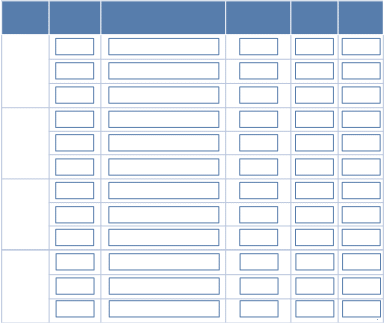 how
to
report
under
“developed
or
revised”
and
“used
or
distributed.”)
how
to
report
under
“developed
or
revised”
and
“used
or
distributed.”)
Products
Number developed or revised
Title/topic Intended audience
Other languages
OMB
Clearance
#
1121-0258
Expiration
Date:
07/31/2004

Training Materials and Training Curricula
Manuals
Newsletter
Posters
Campus Program Semi-annual Progress Report • 22 • Office on Violence Against Women
OMB Clearance # 1122-0005
Expiration Date:
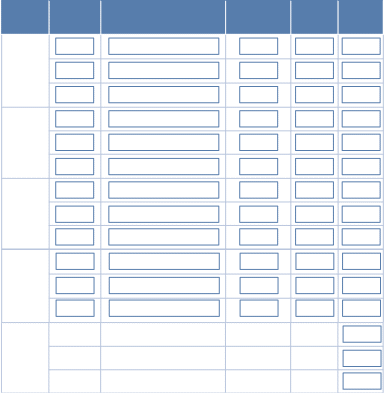 36.
Use of
Campus
Program
funds
for
product
development,
substantial
revision,
or
distribution
(cont.)
36.
Use of
Campus
Program
funds
for
product
development,
substantial
revision,
or
distribution
(cont.)
Products
Number developed or revised
Title/topic Intended audience
Number used or distributed
Other languages
OMB
Clearance
#
1121-0258
Expiration
Date:
07/31/2004

Promo- tional products (wallet cards, key rings, whis- tles, etc.)
Training materials (power point presentations, theatre scripts, etc.)
Training
curricula
Social Media (Twitter; Instagram, etc.)



 Other
Other







 (specify):
(specify):
Campus Program Semi-annual Progress Report • 23 • Office on Violence Against Women
OMB
Clearance
#
1121-0258
Expiration
Date:
07/31/2004
SECTION

Were your Campus Program funds used for data collection systems or communication systems or for the purchase of hardware or other equipment during the current reporting period?
Check yes if Campus Program funds or Campus program-funded staff were used to develop, install, or
expand data collection and/or communication systems. (If the grant funds a consortium proj-
ect, responses in this subsection should reflect the aggregated responses of project members.)
 Yes—answer
questions
37-38
Yes—answer
questions
37-38
 No—skip
to
C7
No—skip
to
C7
![]() 37.
Use
of
Campus
Program
funds
for
data
collection
and/or
communication
systems
37.
Use
of
Campus
Program
funds
for
data
collection
and/or
communication
systems
(Check all that apply.)
 Develop
data
collection/communication
systems
Develop
data
collection/communication
systems
 Install
data
collection/communication
systems
Install
data
collection/communication
systems
 Expand
existing
data
collection/communication
systems
Expand
existing
data
collection/communication
systems
 Link
existing
data
collection/communication
systems
with
local
law
enforcement
Link
existing
data
collection/communication
systems
with
local
law
enforcement


 Share
information
with
other
community
partners
Manage
data
collection
and
communication
Purchase
computers
and
other
equipment
Share
information
with
other
community
partners
Manage
data
collection
and
communication
Purchase
computers
and
other
equipment
![]() 38.
Purpose
of
data
collection
and/or
communication
systems
38.
Purpose
of
data
collection
and/or
communication
systems
 (Indicate
all types
of
information
identified
or
tracked
with
this technology
by
checking
all that
apply.)Arrests
(Indicate
all types
of
information
identified
or
tracked
with
this technology
by
checking
all that
apply.)Arrests
 Case
management
Case
management
 Compliance
with
campus disciplinary
board-ordered
sanctions
Compliance
with
campus disciplinary
board-ordered
sanctions


 Evaluation/outcome
measures
Incident
reports
Evaluation/outcome
measures
Incident
reports


 Campus
disciplinary
boardconditions/violations
Campus
disciplinary
boardconditions/violations
campus disciplinary board hearing schedules



 Protection
orders
Protection
orders
Stalking and harassment orders
 Victim
notification
Victim
notification
 Victim
service
availability
Victim
service
availability
 Other
(specify):
Other
(specify):
OMB
Clearance
#
1121-0258
Expiration
Date:
07/31/2004
SECTION

Were your Campus Program funds used for system and/or capital improvement (but not including con- struction of buildings) during the current reporting period?
Check yes if Campus Program-funded staff engaged in system and/or capital improvement activities
(not including construction of buildings) or if Campus Program funds directly supported system improve-
ments (e.g., interpreters, evaluations, language lines) and/or capital improvements (e.g., improved
lighting, emergency call boxes). (If the grant funds a consortium project, responses in this
subsection should reflect the aggregated responses of project members.)
 Yes—answer
questions
39-40
Yes—answer
questions
39-40
 No—skip
to
section
D
No—skip
to
section
D
![]() 39.
Use of
Campus
Program
funds
for
system
improvement
39.
Use of
Campus
Program
funds
for
system
improvement
(Indicate the system improvement activities supported with your Campus Program funds during the cur-
 rent
reporting
period.
Check
all
that
apply.)
rent
reporting
period.
Check
all
that
apply.)
Victim services Campus police/ Judicial/
security disciplinary board
Evaluation
Assessment or Climate Survey
Homicide Prevention (i.e. Lethality Assessment)
Fatality Review
Interpreters Language lines
Language Access Plans
Translation of forms and documents
Other (specify):
![]() 40.
Use of
Campus
Program
funds
for
capital
improvements
40.
Use of
Campus
Program
funds
for
capital
improvements
(Indicate the capital improvements supported with Campus Program funds during the current reporting
period. Capital improvements do not include the construction of buildings. Check all that apply.)
 Capital
improvements
Capital
improvements


 Emergency
call
boxes
Landscape
design
for
security
Lighting
Emergency
call
boxes
Landscape
design
for
security
Lighting
 Security
cameras
Security
cameras
 Other
(specify):
Other
(specify):
OMB
Clearance
#
1121-0258
Expiration
Date:
07/31/2004
SECTION


Were your Campus Program funds used to provide victim services to victims/survivors during the current reporting period?
Check yes if Campus Program-funded staff provided victim services or if Campus Program funds were
used to support victim services during the current reporting period. (If the grant funds a consortium project, responses in this section should reflect the aggregated responses of project members.)
 Yes—answer
questions
41-48
Yes—answer
questions
41-48
 No—if
no,
please
explain
in
box
below,
and
then
skip
to
section
E
No—if
no,
please
explain
in
box
below,
and
then
skip
to
section
E

![]() 41.
Number of
victims/survivors
served,
partially
served,
and
victims/survivors
seeking
services
who
were
not
served
Please
do
not
answer
this
question
without
referring
to
the
separate
instructions
for
further
explanation
and
examples
of
how
to
distinguish
among
these
categories.
41.
Number of
victims/survivors
served,
partially
served,
and
victims/survivors
seeking
services
who
were
not
served
Please
do
not
answer
this
question
without
referring
to
the
separate
instructions
for
further
explanation
and
examples
of
how
to
distinguish
among
these
categories.
(Report the following, to the best of your ability, as an unduplicated count for each category during the current reporting period. This means that each victim/survivor who was seeking or who received ser- vices during the current reporting period should be counted only once. For purposes of this question, victims/survivors are those against whom the sexual assault, domestic violence, dating violence, and/ or stalking was directed. If the victim/survivor presented with more than one victimization, that person should be counted only once under the primary victimization.)
-
Sexual assault
Domestic violence/ dating violence
Stalking
TOTAL
A. Served: Victims/survivors who received the service(s) they requested, if those services were funded by your Campus Program grant
B. Partially served: Victims/survivors who re- ceived some service(s), but not all of the services they requested, if those services were funded by your Campus Program grant
TOTAL SERVED AND PARTIALLY SERVED (41A+B)
C. Victims/survivors seeking services who were not served: Victims/survivors who sought ser- vices and did not receive the service(s) they were seeking, if those services were funded by your Campus Program grant
![]() 42.
Reasons
that
victims/survivors
seeking
services
were
not
served
or
were
partially
served
42.
Reasons
that
victims/survivors
seeking
services
were
not
served
or
were
partially
served
 (Check
all
that
apply.)
(Check
all
that
apply.)
Conflict of interest
Reasons not served or partially served
Did not meet statutory requirements



 Hours
of
operation
Hours
of
operation
-
Insufficient/lack of culturally appropriate services
Insufficient/lack of language capacity (including sign language)
Insufficient/lack of services for people with disabilities
Lack of child care
Program reached capacity
Program rules not acceptable to victim/survivor
Safety/security risk (due to offender’s behavior)
Services inappropriate or inadequate for victims/survivors with mental health issues
Services inappropriate or inadequate for victims/survivors with substance abuse issues
Services not appropriate for victim/survivor
Services not available for party(ies) based on family composition






 Transportation
Transportation
-
Other (specify):
![]() 43.
Demographics
of
victims/survivors
served
or
partially
served
43.
Demographics
of
victims/survivors
served
or
partially
served
(Based on the victims/survivors reported in 41A and 41B, report the total numbers for all that ap-
ply. Because victims/survivors may identify in more than one category of race/ethnicity, the total for
“Race/ethnicity” may exceed the total number of victims/survivors reported in 41A and 41B. However,
the total number of victims/survivors reported under “Race/ethnicity” should not be less than the total
number of victims/survivors reported in 41A and 41B. The total number of victims/survivors reported
under “Gender” and the total number reported under “Age” should equal the total number of victims/
survivors reported in 41A and 41B. Those victims/survivors for whom gender, age, and/or race/ethnic-
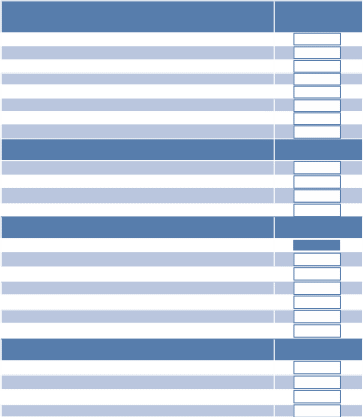 ity
are
not
known
should
be
reported
in
the “Unknown”
category.)
ity
are
not
known
should
be
reported
in
the “Unknown”
category.)
Race (victims/survivors should not be counted more than once in either the category “American Indian and Alaska Native” or in the category “Native Hawaiian and other Pacific Islander.”)
American Indian or Alaska Native
Asian
Black or African American
Native Hawaiian and other Pacific Islander
White
Unknown
TOTAL RACE (should not be less than )
Number of victims/
survivors
OMB
Clearance
#
1121-0258
Expiration
Date:
07/31/2004

Gender Number of victims/
survivors
Female Male
Gender Non-Conforming
Unknown
TOTAL GENDER (should equal )
Age Number of victims/
survivors
0-6
7-10
11-17
18-24
25-59
60+ Unknown
TOTAL AGE (should equal )
Other demographics Number of victims/
survivors
People with disabilities
People with limited English proficiency
People who are immigrants/refugees/asylum seekers
People who are LGTBQ
People who live in rural areas
![]() 44.
Victims/survivors’
relationship
to
offender
by
victimization
44.
Victims/survivors’
relationship
to
offender
by
victimization
(For those victims/survivors reported as served and partially served in 41A and 41B, report the victim/ survivor’s relationship to the offender, by type of victimization. If a victim/survivor experienced more than one type of victimization and/or was victimized by more than one perpetrator, count the victim/ survivor in all categories that apply. The total number of relationships in the sexual assault column must be at least ; the total number in the
domestic violence/dating violence column must be at least ;
and the total number in the stalking column must be at least .
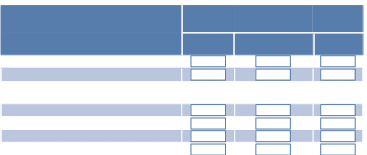
Victims/survivors’ relationship to offender
Number of victim/survivor relationships by victimization
Current or former spouse or intimate partner
Other family or household member
 Acquaintance
(neighbor,
employee,
co-worker,
classmate,
student,
etc.)
Acquaintance
(neighbor,
employee,
co-worker,
classmate,
student,
etc.)
Current or former dating relationship
Stranger
Relationship unknown
TOTAL
Sexual assault
Domestic violence/

 dating
violence Stalking
dating
violence Stalking
Campus Program Semi-annual Progress Report • 29• Office on Violence Against Women
![]() 45.
Victim
services
45.
Victim
services
 (Report
the
number
of
primary
victims/survivors
from
41A
and
41B
who
received
Campus
Program-funded
services.
Count
each
victim/survivor
only
once
for
each
type
of
service
that
the
victim/survivor
received
during the current
reporting
period;
do
not
report
the
number
of
times
that
service
was
provided
to
the
vic- tim/survivor.
The
total
for
each
type
of
service
should not
be
higher
than .
(Report
the
number
of
primary
victims/survivors
from
41A
and
41B
who
received
Campus
Program-funded
services.
Count
each
victim/survivor
only
once
for
each
type
of
service
that
the
victim/survivor
received
during the current
reporting
period;
do
not
report
the
number
of
times
that
service
was
provided
to
the
vic- tim/survivor.
The
total
for
each
type
of
service
should not
be
higher
than .
Type of service
 Academic/education
advocacy
(Actions
designed to
help
the victim/survivor
obtain
needed
support,
resources,
or
services
including assistance
with
course
scheduling,
academic letter
of
support,
etc.)
Academic/education
advocacy
(Actions
designed to
help
the victim/survivor
obtain
needed
support,
resources,
or
services
including assistance
with
course
scheduling,
academic letter
of
support,
etc.)
Number of victims/ survivors
-
Civil legal assistance (Civil legal services provided by an attorney and/or paralegal)
OMB
Clearance
#
1121-0258
Expiration
Date:
07/31/2004



-
Disciplinary board advocacy (Assisting a victim/survivor with issues relating to campus disciplinary board actions such as preparation of statements, accompanying the vic- tim/survivor to disciplinary board hearings, and all other advocacy relating to campus- based proceedings)
Hospital/clinic/other medical response (Accompanying a victim/survivor to, or meeting a victim/survivor at a hospital, clinic, or medical office)
Housing assistance (Assisting a victim/survivor with housing issues including find-
ing a room in a different dorm or finding temporary housing either on- or off-campus;
preventing access by the perpetrator to the victim/survivor’s new residence)



 Legal
advocacy/court
accompaniment
(Assisting
a victim/survivor
with
legal issues including preparing
paperwork
such
as victim impact
statements,
accompanying
a
victim/survivor
to
an
administrative
hearing, court
proceeding,
or
law
enforcement
interview,
and
all
other
advocacy
within
the criminal or
civil
justice
system.
Services
provided
by
an
attorney
and/or
paralegal
should be
reported
in
civil legal assistance.)
Legal
advocacy/court
accompaniment
(Assisting
a victim/survivor
with
legal issues including preparing
paperwork
such
as victim impact
statements,
accompanying
a
victim/survivor
to
an
administrative
hearing, court
proceeding,
or
law
enforcement
interview,
and
all
other
advocacy
within
the criminal or
civil
justice
system.
Services
provided
by
an
attorney
and/or
paralegal
should be
reported
in
civil legal assistance.)
-
Support group/counseling services (Individual or group counseling or support provid- ed by a volunteer, peer, or professional)
Transportation
Victim/survivor advocacy (Actions designed to assist the victim/survivor in obtaining support, resources, or services, including employment, health care, victim’s compen- sation, etc.)
Other (specify):

![]() 45A.
Hotline Support, Information and Referral
calls
45A.
Hotline Support, Information and Referral
calls
(Report the number of hotline support, information or referral calls received from victims/survivors, and the total number of hotline calls received, during the current reporting period. Victims/survivors whose calls are reported here should not be reported as victims served in Question 41 unless they also received at least one of the services described in Question 45 Victim Services. Victims/survivors who receive services such as crisis intervention or victim ad- vocacy over the telephone, in addition to basic hotline information and/or referrals, should also be reported in Question 45. Hotline calls that include victim advocacy or crisis intervention services are those that re- quire more time than the average call and involve a more intensive focus on the immediate needs and situ- ation of the victim. For examples of when to report only the hotline call and when to report both the hotline call and a service or services in Question 45, see separate instructions.)
-
Number of calls from victims/survivors
Total number of calls
Hotline support, information and referral calls (Crisis or information and referral calls received by an agency’s hotline or office telephone)

 Campus
Program
Semi-annual
Progress
Report
•
30
•
Office
on
Violence
Against
Women
Campus
Program
Semi-annual
Progress
Report
•
30
•
Office
on
Violence
Against
Women
![]() 46.
Number of
victims/survivors
reporting
crimes
46.
Number of
victims/survivors
reporting
crimes
OMB Clearance # 1122-0005
Expiration Date: 6/30/2011
(Of the victims/survivors who sought services provided under your Campus Program grant, provide the number who reported crimes of sexual assault, domestic violence, dating violence, and/or stalking to campus police/security or community law enforcement during the current reporting period.)
TOTAL
Where
crime
occurred
Campus
police/
security
local
law
enforcement
TOTAL
On-campus
Off-campus

![]() 47.
(Optional)
Additional
information
47.
(Optional)
Additional
information
 (Use
the space below
to
discuss
the effectiveness
of
victim
services
funded
or
supported
by
your
Cam-
pus Program
grant
and
to
provide
any
additional
information
you
would
like
to
share
about
your
victim
services
activities beyond
what
you
have
provided
in
the data
above.
For
example,
if you
have
wit- nessed an increase in the number
of
victims/survivors
who
are
able to
remain
in school
and
continue
their education
because
of
your
academic
and
housing
advocacy,
you
could
report
that
here.)
(Maximum - 2000 characters)
(Use
the space below
to
discuss
the effectiveness
of
victim
services
funded
or
supported
by
your
Cam-
pus Program
grant
and
to
provide
any
additional
information
you
would
like
to
share
about
your
victim
services
activities beyond
what
you
have
provided
in
the data
above.
For
example,
if you
have
wit- nessed an increase in the number
of
victims/survivors
who
are
able to
remain
in school
and
continue
their education
because
of
your
academic
and
housing
advocacy,
you
could
report
that
here.)
(Maximum - 2000 characters)
Campus Program Semi-annual Progress Report • 31• Office on Violence Against Women
Expiration Date: 6/30/2011
![]() 48.
Protection
orders
48.
Protection
orders
(Report the total number of temporary and/or final protection orders requested and granted for which
Campus Program-funded victim services staff provided assistance to victims/survivors during the cur- rent reporting period. These orders may also be referred to as restraining orders, anti-harassment orders, or no-contact or stay-away orders.)
-
Sexual assault protection orders
Temporary orders
Final orders
Number requested
Number granted
-
Domestic violence/dating violence protection orders
Temporary orders
Final orders
Number requested
Number granted
-
Stalking protection orders
Temporary orders
Final orders
Number requested
Number granted
Expiration Date:
SECTION
E


All grantees must complete this section.
(If the grant funds a consortium project, responses in this section should reflect the aggregated responses of project members.)
In this section, use the numbers from your Clery Act report to provide information for the entire campus or for the campuses represented in your consortium project, to the extent that the informa- tion is available. This applies to all sexual assault, domestic violence, dating violence, and stalking incidents as defined by question 10, that occurred on campus, or in or on non-campus buildings or property, and on public property, that were reported to campus security authorities or local law enforce- ment. Campus security authorities are not restricted to campus police/security officers. See instructions for question 49 for the definitions of “campus” (to include non-campus buildings or property,
and public property) and “campus security authorities” as defined by the Clery Act.
![]() 49.
Number of
incidents
reported
49.
Number of
incidents
reported
(Report the number of sexual assault, domestic violence, dating violence, and/or stalking Iincidents re
 ported
to
campus
security authorities, during the current
reporting
period.)
ported
to
campus
security authorities, during the current
reporting
period.)
 Type
of
incident Number
reported
Type
of
incident Number
reported
Sexual assault
Domestic violence/dating violence
 Stalking
Stalking
TOTAL
![]() 50.
Number of
incidents, criminal
charges
or
referred for campus
disciplinary
action
50.
Number of
incidents, criminal
charges
or
referred for campus
disciplinary
action
(Report the number of incidents in which criminal charges were filed in the local jurisdiction and/or in
which an incident was referred for campus disciplinary action during the current 6 month reporting period.)
 a.
Number
of
incidents
resulting
in
criminal charges
being
filed
in
the
local
jurisdiction
a.
Number
of
incidents
resulting
in
criminal charges
being
filed
in
the
local
jurisdiction
b. Number of incidents resulting in a referral for campus disciplinary action
![]() 51.
Outcomescampus
disciplinary actions
51.
Outcomescampus
disciplinary actions
(Report the outcomes of all campus disciplinary actions resolved during the current
reporting period.)

Type of incident Number Number
Found REsponsibile
OMB
Clearance
#
1121-0258
Expiration
Date:
07/31/2004

Sexual assault
Domestic/dating violence
Stalking
TOTAL
Request of victim
Other
acquitted
Suspension Expulsion Counseling
Community Other service
![]() 52.
Additional
information
52.
Additional
information
 (Use
the space below
to
discuss
the effectiveness
of
law
enforcement
and/or
judicial
and
disciplin-
ary
board
activities
funded
or
supported
by
your
Campus
Program
grant
and
to
provide
any
additional
information
you
would
like
to
share
about
these
activities beyond
what
you
have
provided
in
the data above.
If your numbers appear to be low, please provide an explanation. )
(Maximum
- 2000 characters)
(Use
the space below
to
discuss
the effectiveness
of
law
enforcement
and/or
judicial
and
disciplin-
ary
board
activities
funded
or
supported
by
your
Campus
Program
grant
and
to
provide
any
additional
information
you
would
like
to
share
about
these
activities beyond
what
you
have
provided
in
the data above.
If your numbers appear to be low, please provide an explanation. )
(Maximum
- 2000 characters)
OMB
Clearance
#
1121-0258
Expiration
Date:
07/31/2004
SECTION



All grantees must answer question 54. (If the grant funds a consortium project, responses to this question should reflect the aggregated responses of project members.)

![]() 54.
Report
on
the
status
of
your
Campus
Program
grant
goals
and
objectives
as
of
the
end
of
the
cur-
rent
reporting
period.
54.
Report
on
the
status
of
your
Campus
Program
grant
goals
and
objectives
as
of
the
end
of
the
cur-
rent
reporting
period.
(Report succinctly on the status of the goals and objectives for your grant as of the end of the current
reporting period, as they were identified in your grant proposal or as they have been added or revised.
Indicate whether the activities related to your objectives for the current reporting period have been
completed, are in progress, are delayed, or have been revised. Comment briefly on your successes and
challenges, and provide any additional explanation you feel is necessary for us to understand what you
have or have not accomplished relative to your goals and objectives. If you have not accomplished ob-
jectives that should have been accomplished during the current reporting period, you must provide an
 explanation.)
explanation.)
All grantees must answer questions 55 and 56 on an annual basis. Submit this information on the Janu- ary to June reporting form only. (If the grant funds a consortium project, responses to these questions should reflect the aggregated responses of project members.)
Please limit your response to the space provided (8,000 characters, approximately two pages of continu- ous single-spaced text) for each question.
![]() 55.
What
do
you
see
as
the
most
significant
areas
of
remaining
need,
with
regard
to
improving
services
to
victims/survivors
of
sexual
assault,
domestic
violence,
dating
violence,
and
stalking,
increasing
victims/survivors
safety,
and
enhancing
community
response
(including
offender
accountability
for
both batterers
and
sex
offenders)?
55.
What
do
you
see
as
the
most
significant
areas
of
remaining
need,
with
regard
to
improving
services
to
victims/survivors
of
sexual
assault,
domestic
violence,
dating
violence,
and
stalking,
increasing
victims/survivors
safety,
and
enhancing
community
response
(including
offender
accountability
for
both batterers
and
sex
offenders)?
(Consider underserved populations, campus-community collaborations, campus disciplinary board re-
sponse, student safety, challenges implementing prevention and education programs across campus,
and/or challenges and barriers unique to your institution or service area.)
![]() 56.
What
has
Campus
Program
funding
allowed
you
to
do
that
you
could
not
do
prior
to
receiving
this
funding?
56.
What
has
Campus
Program
funding
allowed
you
to
do
that
you
could
not
do
prior
to
receiving
this
funding?
(For example, the money allowed us to make capital improvements; install data collection or commu- nication systems; revise campus disciplinary board procedures; create and implement prevention and education programs; and train campus administrators, campus disciplinary board members, and secu-rity personnel.)
 Questions
57
and
58
are
optional.
Questions
57
and
58
are
optional.
Please limit your response to the space provided (8,000 characters, approximately two pages of continu- ous single-spaced text) for each question.
![]() 57.
Provide
additional
information
that
you
would
like
us
to
know
about
your
Campus
Program
and/or
the
effectiveness
of
your
grant.
57.
Provide
additional
information
that
you
would
like
us
to
know
about
your
Campus
Program
and/or
the
effectiveness
of
your
grant.
(If you have any other data or information that you have not already reported in answer(s) to previous
questions that demonstrate the effectiveness of your Campus Program grant, please provide it below.
Refer to separate instructions for a more detailed explanation and example. Feel free to discuss any of
the following: institutionalization of staff positions, policies, and/or protocols; systems-level changes;
community collaboration; results of pre-tests and post-tests; the removal or reduction of barriers and
challenges for victims/survivors; utilization of volunteers and/or interns to complete activities; promis-
ing practices; and positive or negative unintended consequences.)
OMB Clearance # 1122-0005
Expiration Date: 6/30/2011
![]() 58.
Provide
any
additional
information
that
you
would
like
us
to
know
about
the
data
submitted.
58.
Provide
any
additional
information
that
you
would
like
us
to
know
about
the
data
submitted.
(If you have any information that could be helpful in understanding the data you have submitted in this report, please answer this question. For example, if you submitted two different progress reports for the same reporting period, you may explain how the data was apportioned to each report; or if you funded staff—e.g., victim advocates—but did not report any corresponding victim services, you may explain
why; or if you did not use program funds to support either staff or activities during the reporting period, please explain how program funds were used, if you have not already done so.)
Public Reporting Burden
Paperwork Reduction Act Notice. Under the Paperwork Reduction Act, a person is not required to respond to a collection of information unless it displays a currently valid OMB control number. We try to create forms and instructions that are accurate, can be easily understood, and which impose the least possible burden on you to provide us with information. The estimated average time to complete and file this form is 60 minutes per form. If you have comments regarding the accuracy of this esti- mate, or suggestions for making this form simpler, you can write to the Office on Violence Against Women, U.S. Department of Justice, 145 N Street, NE, Washington, DC 20530..
Campus Program Semi-annual Progress Report • 36 • Office on Violence Against Women
 Describe
your goals and objectives, as outlined in your grant proposal, or as
revised - Question #54
Describe
your goals and objectives, as outlined in your grant proposal, or as
revised - Question #54
Goals/Objectives
Key Activities
Status
 Comments
Comments
Goals/Objectives
Status
Key Activities
Comments
Goals/Objectives
Key Activities
Status
 Comments
Comments
Goals/Objectives
Status

Key Activities
Comments
APPENDIX A
OMB Clearance # 1122-0005
Expiration Date: 6/30/2011
 Describe
your goals and objectives, as outlined in your grant proposal, or as
revised - Question #54
(cont.
2)
Describe
your goals and objectives, as outlined in your grant proposal, or as
revised - Question #54
(cont.
2)
Goals/Objectives
Key Activities
Status
Comments
Goals/Objectives
Status
Key Activities
Comments
 Grants
to Reduce Violent
Crimes
Against
Women
on
Campus Program Semi-annual Progress Report •
39 • Office
on
Violence
Against
Women
Grants
to Reduce Violent
Crimes
Against
Women
on
Campus Program Semi-annual Progress Report •
39 • Office
on
Violence
Against
Women
 Question
#55
Question
#55
Campus Program Semi-annual Progress Report • 40 • Office on Violence Against Women
 Question
#55
(cont.)
Question
#55
(cont.)




 Question
#58
Question
#58
THIS IS A SAMPLE GMS FORM. DO NOT USE THIS FORM TO SUBMIT YOUR FINAL DAT 8Ya nce #
_
1122 0005
Expiration Date: 6130/2011
Provide any additional information that you would like us to know about the data submitted.
 Question
#58
(cont.)
Question
#58
(cont.)
Campus Pro am Semi-annual Progress Report • 47 • Office on Violence Against Women
THIS IS A SAMPLE GMS FORM. DO NOT USE THIS FORM TO SUBMIT YOUR FINAL DATA TO OVW.
OMB Clearance # 1122-0005
Expiration Date: 6/30/2011
THIS
IS A
SAMPLE
GMS FORM.
DO
NOT
USE THIS FORM
TO
SUBMIT YOUR
FINAL
DATA
TO
OVW.
| File Type | application/vnd.openxmlformats-officedocument.wordprocessingml.document |
| File Modified | 0000-00-00 |
| File Created | 0000-00-00 |
© 2025 OMB.report | Privacy Policy